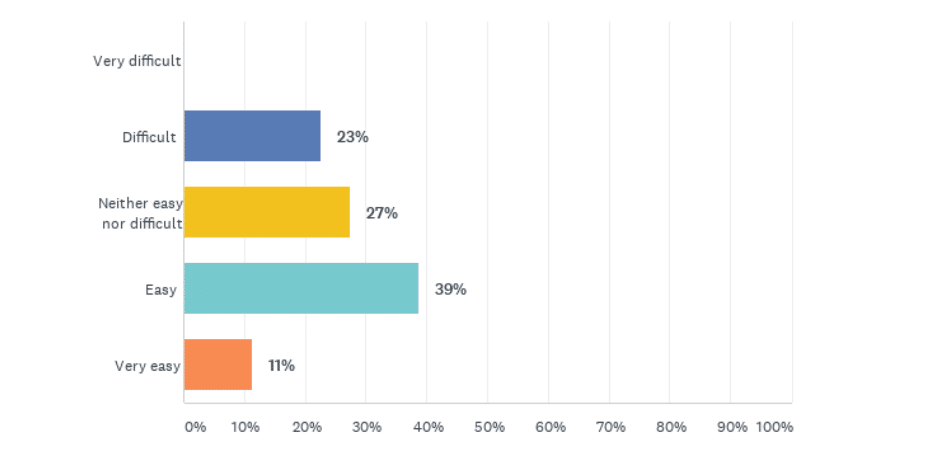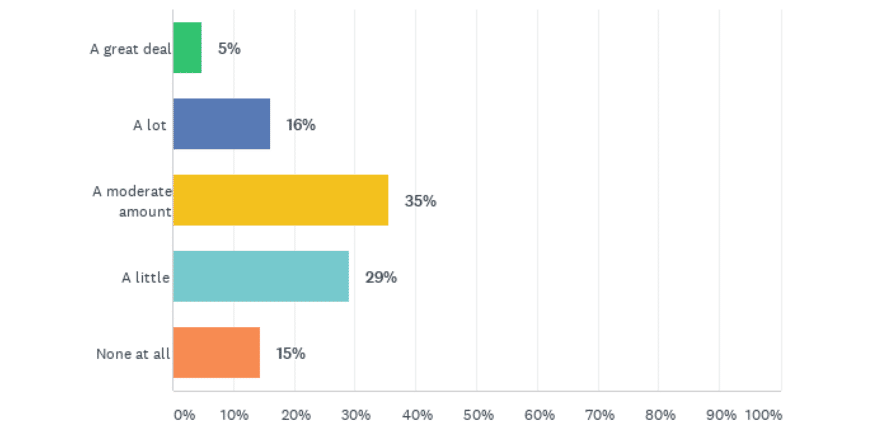Most of us are working remotely these days, and that includes creatives and designers. According to new research from workflow software firm inMotionNow examining the COVID crisis’ impact on the creative community, these pros seem to be well-adapted to the move.
Of course, there are plenty of challenges, but thanks to the agility and adaptability that’s inherent in creative talent, many say they are still getting their jobs done.
A closer look at the findings:
Most creatives are working remotely because of the pandemic
The vast majority of creatives (92 percent) report their team is now working remotely 100 percent of the time. The remainder (8 percent) said their team is partially working remote as a result of the pandemic.
How would you characterize the transition to remote work?

Creatives took the transition to remote work in-stride
Half of creatives said the process of transitioning to remote work was “easy” (39 percent) or “very easy” (11 percent). Another 27 percent were indifferent and indicated the transition was “neither difficult nor easy.” About a quarter (23 percent) said the transition was “difficult,” however no respondents labeled the transition “very difficult.”
Fifty respondents wrote in open-ended comments to share why. Many of the comments had common themes. Below are some representative answers:
Those that said the transition was easy:
- “The largest challenge is that some colleagues miss one another; miss in-person connections.”
- “Focus (kids at home, homeschooling, etc.), social aspects (missing colleagues and coffee machine chats) & fear (of how everything is going to work out. Thankfully, no fear for job as that is quite secure for the time being).”
- “The influx of projects directly related to COVID-19, while undertaking major projects like website redesign and email system migration and having to prioritize projects daily. Figuring out how to collaborate and harness that ‘creative connection’ that comes from working face-to-face with the team virtually. Some of the team has had to figure out how to set boundaries so as to not work 24/7, while others have not put in their full time because of the nature of remote work.”
Those that said the transition was neither hard nor easy:
- “Technology set up – none of us worked remotely so it was challenging at first to get our home offices set up and make sure we were linked to the VPN, had Zoom, etc.”
- “Fortunately, our team already took turns working from home, so we were already quite established with remote working procedures.”
- “Balancing work with family care; increase of workload; budget challenges.”
Those that said the transition was difficult:
- “We do a lot of collaborative work and my focus is on strategy. There is a lot of information that is lost without fast and rich interpersonal communication, troubleshooting, and brainstorming.”
- “VPN, internet, collaboration and struggles with team meeting goals and staying on task.”
- “Managing work-life against family life at home juggling children and professional schedules over-abundance of meetings being scheduled in lieu of clear emails or other quick requests/conversations.”
The pandemic has had a modest impact on creative work
Most creatives say the work circumstances caused by the coronavirus has “a little” (29 percent) to “moderate” (35 percent) impact on their ability to work. However, 15 percent said the pandemic has no impact at all, while about one-fifth (21 percent) said it has adversely affected their ability to get things done (“a lot” or “a great deal”).
What level of impact has the Coronavirus had on your ability to accomplish work?

The biggest challenges facing organizations during the pandemic
The firm asked respondents an open-ended question—what’s been your organization’s biggest challenge in responding to the pandemic?—and 54 wrote in answers. Here is a representative sample of those answers:
- “Staying relevant and getting the ‘right’ things done.”
- “Making sure everyone has what they need to be productive. Trying to figure out how to have companywide town halls.”
- “Budget impact.”
- “Clear communication for organizational leadership about best courses of action, timelines, and commitment to decisions.”
- “Network and technology issues and increased demand for deliverables.”
- “Having to pivot on our upcoming events and turn them into virtual ones in a short amount of time.”
Most creative teams are using a cloud-based tool
Cloud technology has come into focus during the pandemic because it provides access to software tools and data to do a job from anywhere with an internet connection. Most respondents (82 percent) say their creative organization already uses cloud-based workflow or project management tools. Unsurprisingly, the data does suggest that those with cloud-based tools were more likely to report an easier transition to remote work.
What creatives need from technology providers to do better
The firm asked respondents what technology vendors could do to help them in navigating these challenging times. Here are some representative comments:
- “Ensure easy, seamless, comprehensive tools or integration. So, we aren’t jumping from one tool to the other.”
- “Provide more and better online training materials for their products.”
- “Faster, faster, faster product speeds!”
- “Make our jobs easier and the software easier to use.”
- “Super responsive support to keep everything going.”

A total of 62 creative professionals took the online survey which was conducted from Friday, April 24, 2020, until Tuesday, May 5, 2020. Respondents come from a wide range of industries including health care, higher education, financial services, retail, technology, hospitality and entertainment.



